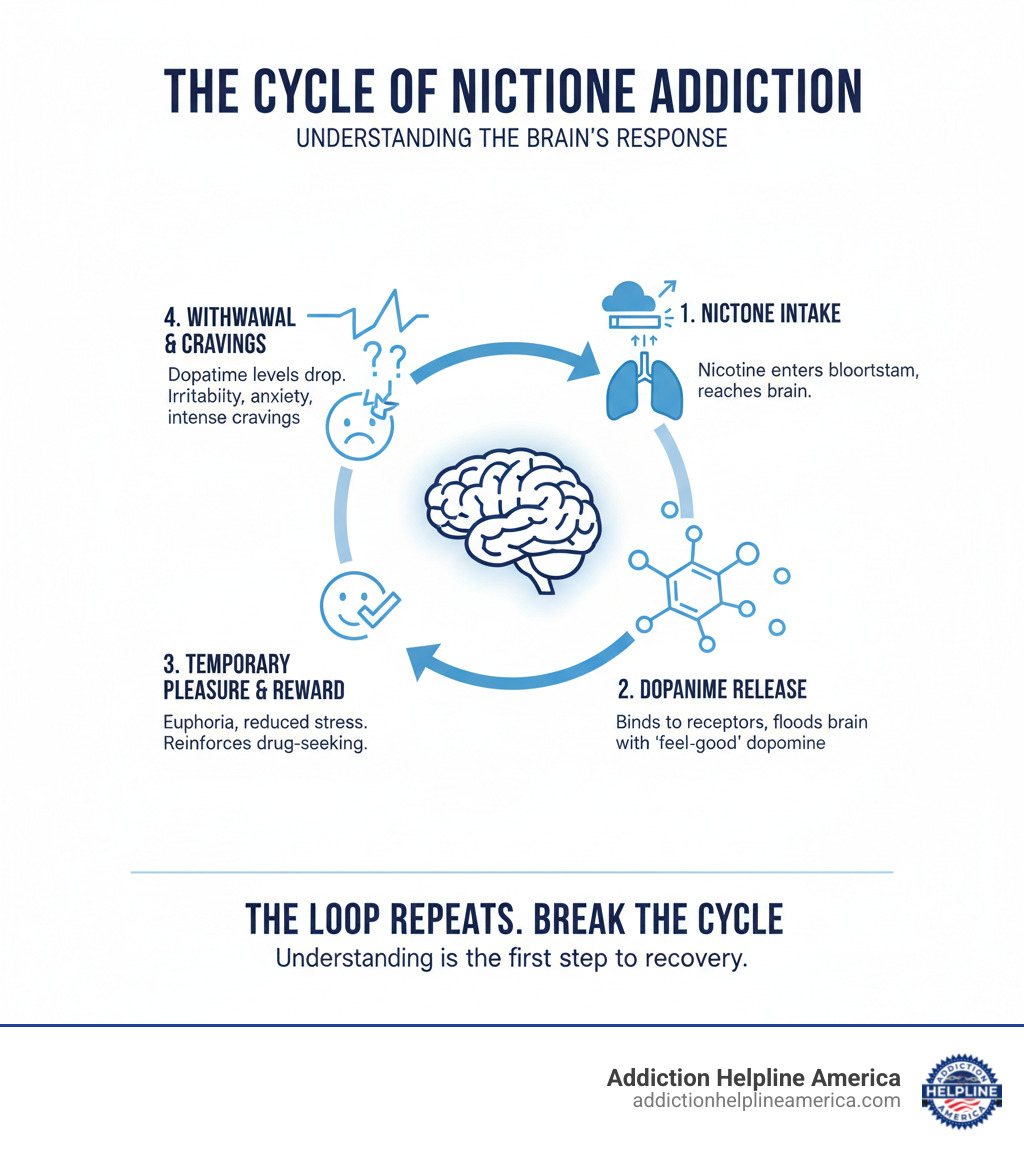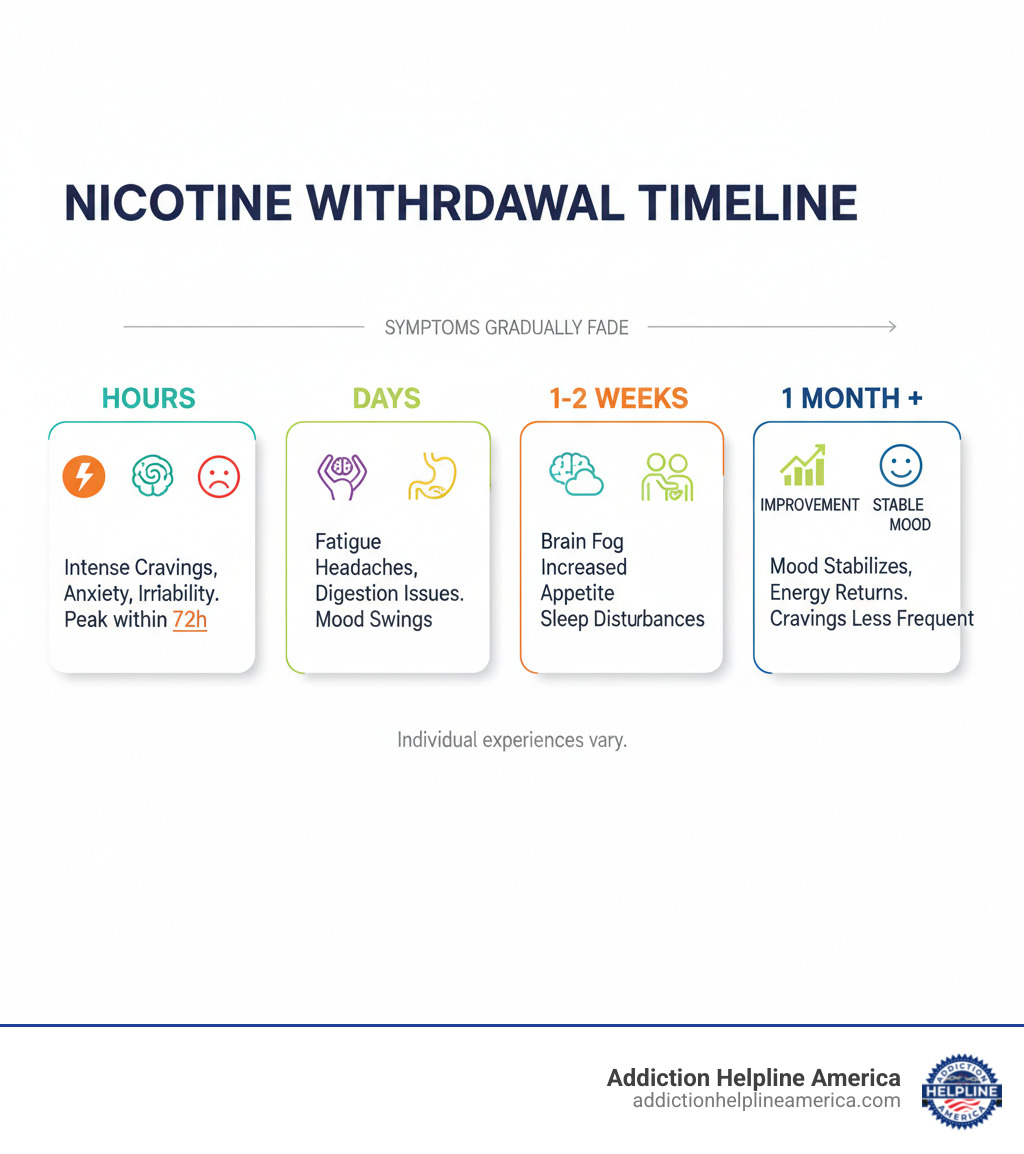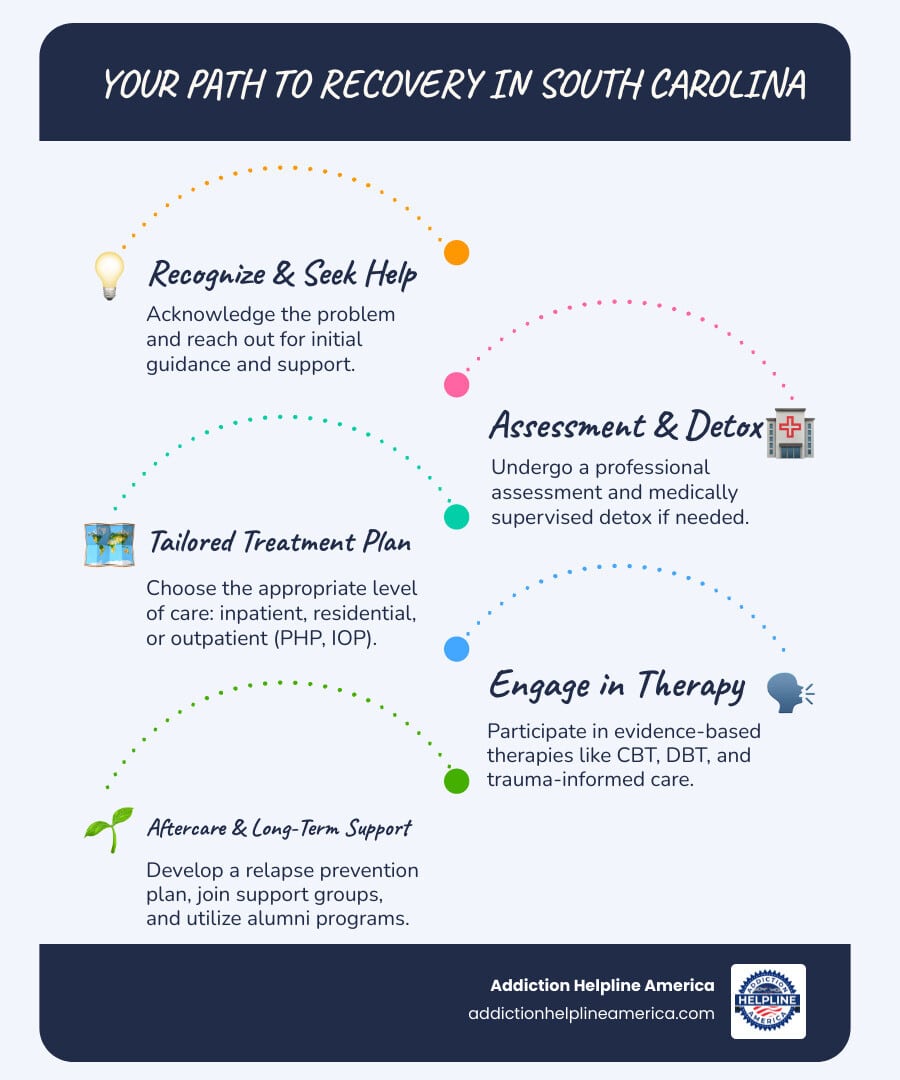
What You Need to Know About Nicotine Withdrawal
Nicotine withdrawal symptoms are the temporary physical and mental effects you experience when you stop using nicotine after your body has become dependent. While uncomfortable, these symptoms are a natural part of your body healing.
Common Nicotine Withdrawal Symptoms:
Physical Symptoms:
- Intense nicotine cravings
- Increased appetite and weight gain
- Headaches and dizziness
- Coughing and sore throat
- Fatigue
- Constipation
Emotional and Mental Symptoms:
- Irritability and frustration
- Anxiety and restlessness
- Depressed mood
- Difficulty concentrating
- Trouble sleeping
Timeline:
- Symptoms begin 4-24 hours after your last dose
- Peak intensity occurs on days 2-3
- Most symptoms fade within 2-4 weeks
Nicotine addiction powerfully affects your brain chemistry, specifically the release of dopamine. When you quit, your brain needs time to adjust, which causes these withdrawal symptoms. The good news is that these symptoms are not dangerous. They are signs that your body is recovering.
At Addiction Helpline America, we’ve guided thousands through the challenges of overcoming substance dependence, including nicotine withdrawal symptoms. We know quitting is one of the most important decisions you can make for your health, and we’re here to help.

What is Nicotine Withdrawal and Why Does It Happen?
When you stop using nicotine after regular use, you experience a collection of physical, mental, and emotional symptoms known as nicotine withdrawal. This occurs because your brain and body have become dependent on the substance and need time to adjust to its absence.
The science behind nicotine withdrawal symptoms is rooted in brain chemistry. Nicotine travels to your brain in seconds, latching onto receptors and triggering a release of dopamine the chemical that makes you feel rewarded and motivated. This dopamine rush is what makes nicotine so powerfully addictive.
As you continue using nicotine, your brain adapts to these artificially high dopamine levels. It begins to expect nicotine and develops a tolerance, meaning you need more to get the same effect. When you quit, your brain’s chemistry is thrown out of balance, causing the uncomfortable symptoms of withdrawal. The psychological side is also powerful, as you must break the mental connections that tie nicotine use to daily routines like your morning coffee or work breaks.
For more detailed information, check out our guide on Understanding Nicotine Withdrawal Symptoms. For peer-reviewed background on how withdrawal is defined and measured, see Scientific research on the withdrawal construct.
The Science Behind the Cravings
Intense cravings are a real, physical response to quitting. Nicotine rewires your brain’s reward system, teaching it to seek out nicotine just as it seeks food or water. This is not a character flaw; it’s neurobiology.
Call Now – Your Journey to Recovery Begins Today!

Take the first step towards a healthier life! Call now to connect with our compassionate team and start your recovery journey today. Your path to healing awaits!
Our recovery specialists are available 24/7 to provide support, and all calls are confidential and free. Reach out anytime – we’re here to help!
When you stop using nicotine, your dopamine levels plummet. Your brain, now reliant on nicotine for its chemical balance, sends out urgent signals demanding more. These signals are what you experience as cravings. This is the body’s adjustment period, during which your brain works to relearn how to regulate dopamine on its own. Understanding that nicotine is as addictive as heroin or cocaine can help you recognize that the difficulty of quitting has a real biological basis.
For more context on how nicotine compares to other substances, visit our page on Most Common Addictions.
Who Experiences Nicotine Withdrawal?
Anyone who uses nicotine regularly can experience nicotine withdrawal symptoms when they stop. This includes smokers of cigarettes and cigars, vapers who use e-cigarettes, and smokeless tobacco users.
The severity of withdrawal varies from person to person and is influenced by several factors:
- Amount and Duration of Use: A long-term, heavy user will likely have a more challenging experience than a short-term, light user.
- Genetics: Your genetic makeup can affect how you metabolize nicotine and experience withdrawal.
- Age: Nicotine can have a stronger effect on developing brains, potentially making withdrawal more intense for younger people.
Everyone’s withdrawal journey is unique, but the underlying biology is the same: your brain became dependent and now needs time to heal.
A Complete Guide to Nicotine Withdrawal Symptoms

Starting your journey to a nicotine-free life means your body and mind will go through significant changes. The nicotine withdrawal symptoms you’ll experience are normal and are proof that your body is healing and rebalancing itself. Understanding what to expect makes the process far less frightening and helps you stay committed.
Common Physical Nicotine Withdrawal Symptoms
Your body will let you know it’s adjusting in several physical ways. The most notorious symptom is intense cravings, which typically last only 15 to 20 minutes each. If you can distract yourself and ride out the wave, it will pass.
Many people notice their appetite increases as their senses of taste and smell recover. Nicotine also suppresses appetite and speeds up metabolism, so your body is readjusting. Headaches and dizziness are also common as your body gets more oxygen and blood flow changes.
You might start coughing more or have a sore throat after you quit. This is a positive sign that your lungs are clearing out accumulated tar and mucus. Feeling tired and sluggish is also extremely common, as your body adjusts to functioning without nicotine’s stimulant effect.
Finally, your digestive system might protest. Constipation can occur because nicotine affected your digestive tract. Drinking more water and eating fiber-rich foods can help ease this symptom.
Emotional and Mental Nicotine Withdrawal Symptoms
The emotional side of withdrawal can be just as challenging. Your brain chemistry is rebalancing, which directly affects your mood and thinking.
Irritability, anxiety, and restlessness are among the most common complaints. You might feel short-tempered or on edge. This is your brain chemistry adjusting, not a reflection of your character. Many people also experience a depressed mood or sadness. While this feels rough, research shows that after a few months of being smoke-free, mood levels often improve significantly.
Brain fog is another frustrating but common symptom. You might struggle to focus or remember things as your brain learns to function without nicotine’s stimulation. Sleep problems, such as insomnia or vivid dreams, are also typical as your sleep patterns are disrupted.
All these changes can lead to mood swings. Understanding that these challenges are a biological part of the healing process is crucial. You’re not failing; your brain is recovering from addiction. For those dealing with broader challenges, our resources on Substance Use Disorders can provide additional support.
The Withdrawal Timeline: How Long Do Symptoms Last?
One of the most common questions about quitting is, “How long will I feel this way?” The good news is that nicotine withdrawal symptoms follow a predictable pattern. While the experience varies, understanding the general timeline can help you prepare for what’s ahead.
Symptoms usually start within hours of your last dose, peak within the first few days, and then gradually fade over the following weeks. Most people find that the acute physical symptoms disappear within two to four weeks. After that, it’s primarily a mental game of managing psychological cravings, which also become less intense over time. For a research-backed overview of symptom time course, see Effects of abstinence from tobacco: valid symptoms and time course.

First 72 Hours: The Peak Challenge
The first 72 hours are the steepest part of the climb. This is when nicotine withdrawal symptoms are at their most intense. If you can make it through these three days, you’ve conquered the worst of the physical withdrawal.
- Within 4-24 hours: Nicotine levels drop significantly, triggering the first distress signals from your brain. You may feel restless, anxious, and irritable, with strong cravings.
- Days 2-3: This is typically when withdrawal symptoms reach their peak. Expect the strongest cravings, persistent headaches, and intense irritability. Some people also experience feelings of sadness or depression. An increase in coughing may also begin as your lungs start to clear out.
The key to surviving these first three days is knowing they won’t last forever. Every hour that passes is an hour closer to feeling better.
Call Now – Your Journey to Recovery Begins Today!

Take the first step towards a healthier life! Call now to connect with our compassionate team and start your recovery journey today. Your path to healing awaits!
Our recovery specialists are available 24/7 to provide support, and all calls are confidential and free. Reach out anytime – we’re here to help!
Week 1 to Month 1: Your Body Recovers
After the intense first week, your body begins to truly recover, and nicotine withdrawal symptoms start to lose their grip.
Most physical symptoms gradually fade over the next three to four weeks, with many people reporting they are almost gone by the end of the first month. Your brain is slowly rebalancing its chemistry and learning to function without nicotine.
During this period, your cough may temporarily increase as your lungs’ cleaning mechanisms (cilia) recover and clear out debris. Your appetite and sleep patterns will start to normalize, though you may still feel hungrier than usual as your senses of taste and smell improve.
It’s important to know that most relapses happen within the first two weeks. This statistic highlights why having support and solid coping strategies is so crucial during this time. At Addiction Helpline America, we’ve seen how the right support system can help people successfully steer this challenging period.
While physical withdrawal subsides, psychological cravings can persist. However, each time you resist a craving, you rewire your brain and make the next one easier to handle.
Proven Strategies for Managing Withdrawal

Nicotine withdrawal symptoms don’t have to be something you just suffer through. With a proactive plan that includes medical support, lifestyle adjustments, and behavioral techniques, you can significantly reduce their intensity and increase your chances of success.
Medical Support and Nicotine Replacement Therapy (NRT)
Going cold turkey is tough and often not the most effective path. Medical support can make a significant difference.
Nicotine Replacement Therapy (NRT) delivers controlled doses of nicotine without the harmful chemicals in tobacco. This reduces the severity of nicotine withdrawal symptoms and cravings, allowing you to focus on breaking behavioral habits. NRT can increase your chance of quitting by 50 to 60 percent. Options include:
- Patches: Provide a steady, all-day dose.
- Gum and Lozenges: Offer flexible, quick relief for cravings.
- Inhalers and Nasal Sprays: Work quickly and mimic the hand-to-mouth action of smoking.
Prescription medications are another powerful option. Varenicline (Chantix) reduces cravings and blocks the pleasurable effects of nicotine. Bupropion (Zyban) can also reduce withdrawal symptoms and may help manage weight gain.
We strongly encourage you to talk with a healthcare provider. They can help you develop a personalized plan that fits your life. If you’re struggling with other dependencies, our Opioid Dependence Addiction Helplines are also available.
Lifestyle and Behavioral Techniques to Cope
Lifestyle changes and behavioral techniques are just as powerful as medical support in managing nicotine withdrawal symptoms.
- Use the 4 D’s: When a craving hits, Delay for 10 minutes, take slow Deep breaths, Drink water, and Distract yourself with a new activity.
- Get Regular Exercise: Even a 15-minute walk can boost your mood, relieve stress, and help manage your appetite.
- Eat a Healthy Diet: Focus on nutrient-rich foods and drink plenty of water to help your body detoxify and combat constipation. Keep healthy snacks on hand.
- Practice Good Sleep Hygiene: Create a relaxing bedtime routine, avoid caffeine in the afternoon, and limit screen time before bed.
- Manage Stress: Since you can no longer use nicotine to cope, find new stress management tools like yoga, meditation, or deep breathing exercises.
- Identify and Avoid Triggers: In the early weeks, try to avoid situations, people, or places that you associate with nicotine use. Change your daily routine to break powerful associations.
- Keep Hands and Mouth Busy: Chew sugarless gum, suck on hard candy, or use a fidget toy to manage the physical habit.
Beyond Withdrawal: Benefits of Quitting and When to Get Help

Dealing with nicotine withdrawal symptoms is tough, but the discomfort is temporary, while the benefits of quitting last a lifetime. Focusing on what’s waiting on the other side can help you push through the immediate struggle.
The Long-Term Rewards of a Nicotine-Free Life
Your body is remarkably resilient and begins healing the moment you quit.
- Improved Lung and Heart Health: Your lungs start recovering almost immediately. Within a year, breathing becomes easier, and after 10-15 years, your risk of lung cancer drops to half that of a smoker. Your risk of heart disease also drops dramatically within a few years.
- Improved Senses: Within just a week, many people experience a dramatic improvement in their sense of taste and smell.
- Financial Savings: Quitting a pack-a-day habit could save you thousands of dollars a year. Think about what you could do with that extra money.
- Better Appearance and Well-being: Quitting slows skin aging, whitens teeth, and freshens breath. After the initial withdrawal period, most people report feeling less stressed than they did when they were using nicotine.
- Protecting Loved Ones: You’re also protecting your family and friends from the dangers of secondhand smoke.
When to Seek Professional Help
While many can manage nicotine withdrawal symptoms with the right strategies, it’s smart to recognize when you need more support.
Seek professional help if:
- Your symptoms are overwhelming or don’t improve after several weeks.
- You experience severe or prolonged depression or anxiety.
- You have any thoughts of harming yourself. This is an emergency. Please call or text the 988 Suicide & Crisis Lifeline at 988 or call 911 immediately.
- Withdrawal makes it impossible to function at work or at home.
- You feel isolated and don’t have a support system to lean on.
At Addiction Helpline America, we connect people with the resources they need to succeed. Visit our Addiction and Rehab Hotlines page to find the support you need, whenever you need it.
Call Now – Your Journey to Recovery Begins Today!

Take the first step towards a healthier life! Call now to connect with our compassionate team and start your recovery journey today. Your path to healing awaits!
Our recovery specialists are available 24/7 to provide support, and all calls are confidential and free. Reach out anytime – we’re here to help!
Your Path to a Nicotine-Free Future Starts Now
You’ve learned that nicotine withdrawal symptoms, while challenging, are temporary signs that your body is healing. The cravings, irritability, and restlessness will pass. The benefits—better health, more money, and freedom from addiction—will last a lifetime.
You have the tools to make this journey manageable, from medical support like NRT to behavioral strategies like the “4 D’s.” But you don’t have to do it alone. Quitting is hard, and seeking help is a sign of strength, not weakness.
Withdrawal follows a predictable pattern: it starts within hours, peaks around days 2-3, and gradually fades over 2-4 weeks. Every uncomfortable moment is your body repairing itself.
If you’re feeling overwhelmed, if your symptoms are severe, or if you just need guidance, Addiction Helpline America is here. We provide free, confidential, personalized support to connect you with the right resources for your situation. We’ve helped thousands of people overcome nicotine dependence, and we can help you too.
Your path to a nicotine-free future starts now. You’ve already taken the first step by educating yourself. The next step is yours to take, and we’ll be here to support you.
Find confidential support and resources on our Addiction and Rehab Hotlines page
Our helpline is 100%
free & confidential
If you or someone you care about is struggling with drug or alcohol addiction, we can help you explore your recovery options. Don’t face this challenge alone—seek support from us.
Programs
Resources
Will my insurance
cover addiction
treatment?
We're ready to help
Find the best
drug or alcohol treatment
center
Are you or a loved one struggling with addiction? Call today to speak to a treatment expert.
















